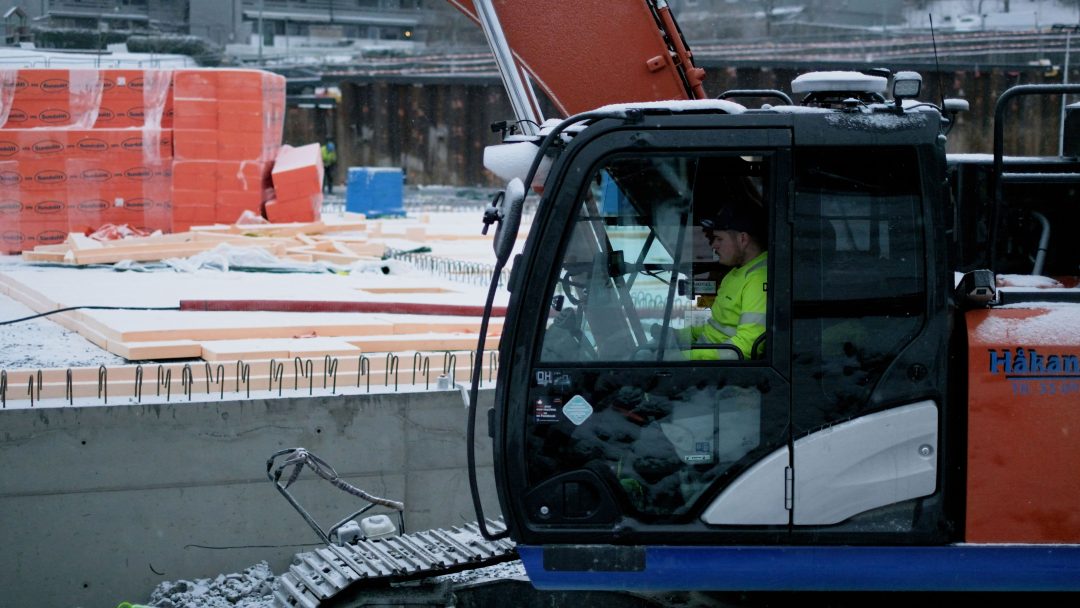Most of us associate a construction site with noise and air pollution. In addition to the environmental challenges related to emissions, this is bothersome for neighbors, the local community, and everyone working on the site. In other words, there are many good reasons to invest in the electrification of construction sites.
At Stovner bad, NCC and Oslobygg KF have high sustainability ambitions. The construction site is partially emission-free and has a high proportion of electric machines, with four electric excavators and two electric cranes, in addition to an electric concrete pump that is widely used. By 2025, the construction site is set to be completely emission-free, and the construction process will be carried out as a fossil-free site. To achieve this, many good forces have worked together, and planning started early. The client, the City of Oslo, has installed high-voltage power on the site to provide enough electricity for charging the large electric machines in use.
Requirements for emission-free construction sites are coming
Espen Foss Johansen, project manager at Oslobygg, says this was a crucial measure that was prioritized early on. «To plan an emission-free construction site, it’s important to start early by defining the power requirements for the machines we will use and how much electricity we can get near the construction site. In some cases, we need to dig to lay enough power. Sometimes we also need a temporary transformer. All this requires a lot of planning well in advance. An important reason for electrifying is because the City of Oslo demands it, but we also have our own requirements in Oslobygg. We obviously want to take social responsibility and contribute to reduced CO2 emissions.»
The City of Oslo has set clear requirements for contractors to transition in the coming years. From 2025, all construction work on behalf of the municipality must be carried out emission-free, and by 2030, the entire construction industry in Oslo must be emission-free.
«The advantages of an electric machine are obviously less emissions and noise reduction, but I also find it quicker to use than those running on diesel. You have 100% power as soon as you move the lever. It’s fast, and there’s no lag like you have with diesel machines. But the biggest difference I notice is that the noise is gone.»
Many people who drive electric cars may have experienced range anxiety and poor battery life in winter cold. How does Martin experience this in his excavator on a cold December workday?
«Charging this machine is as simple as charging an electric car. You just plug it in and swipe the card, and we’re good to go. Charging time varies depending on whether we use a fast charger or a long-term charger. With a fast charger, it’s ready in about 45 minutes. We charge during lunch and dinner breaks, and that lets us run all day regardless of the season. At night, we use a long-term charger because it preserves the battery better.»
The biggest difference I notice is that the noise is gone.

It is nice and warm in the cabin. And the charging happens during the lunch break. Pål Laukli
An emission-free construction site benefits everyone
The construction process at Stovner bad is groundbreaking in many areas by facilitating and implementing the work to create the construction site of tomorrow, where reducing climate emissions and noise is central. The construction industry accounts for significant emissions, and local air pollution is strongly felt by both residents and workers.
Globally, the construction sector accounts for 37% of all emissions, with the production of cement, steel, and aluminum contributing significantly. Therefore, the project at Stovner is being closely followed by many actors, including those from abroad. Manufacturers of electric construction machines come here to gain more experience on how the machines can be developed and improved. The project leads the way in developing more environmentally friendly solutions, and it is important that experiences are shared as widely as possible.
The major advantage of electric operation is much less local air pollution and noise on the construction site.
This article was translated from Norwegian with the assistance of AI.






